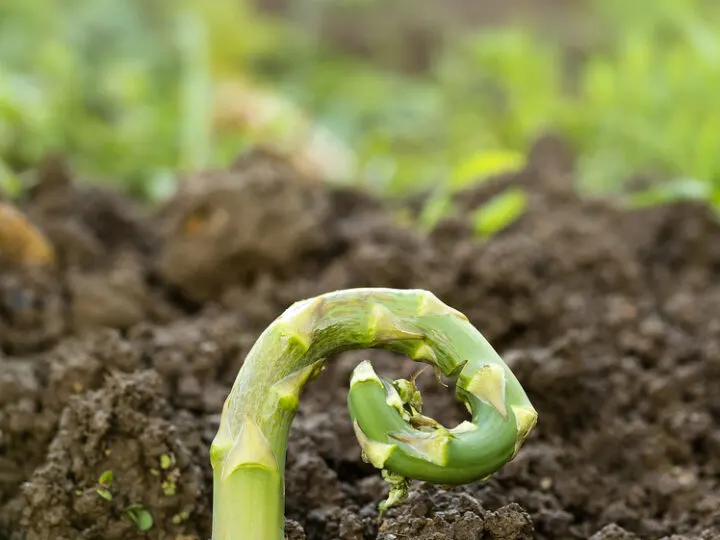When you’ve been waiting patiently for your crops to sprout after growing them from seed, it can be disappointing if there is something visibly wrong with them once they break the soil’s surface. They can be oddly colored, get stuck at a specific size, or look different than they should. Specifically, they may have deformed leaves; but what is the cause of this? Deformation can be abnormally small leaves, leaves that are curled, twisted, or even just weirdly shaped. Now, you are probably wondering why are my seedling leaves deformed?
There are many reasons that your seedling leaves are deformed. You may be over or underwatering; the weather conditions could be too hot, cold, or windy. Also, pests, diseases, or a lack of essential nutrients could cause deformations.
Continuing reading for a list of all the key causes of seedling leaf deformations and explanations of how you can fix them.

Symptoms of Deformed Seedling Leaves- Causes & Solutions
Seedlings are vulnerable to all sorts of things. Because of their small size, especially in the early weeks, the chance for deformeties is actually quite high.
Having grown tons of plants in my time, I think it may be nice to share all of the different types of causes along with symtpoms that result in deformed seedlings. I’ll also share some easy ways to fix them.

| Symptoms | Cause of Deformation | Solutions (How To Fix Them) |
| A sudden stop or stunt in growth, causes distorted or abnormally small leaves. | A severe lack of nitrogen will completely stop the growth of seedling leaves. Seedlings are typically able to provide themselves with enough nutrients to sprout and grow a leaf or two but most of the time they need to be supported with extra nutrients to continue growing. If not, their growth will be stunted. | Purchase a fertilizer or use compost that contains an adequate amount of nitrogen and is safe for seedlings. |
| Leaf distortion and curling. | Insects like whiteflies and spider mites will feed off of seedling leaves. In the process, they damage the tissue of the leaves and cause them to curl and/or distort. | Place your seedlings inside in a sunny window instead of outside where bugs have access to them. If you have to place them outside, make sure they are covered with plastic or in a secure greenhouse, away from critters. |
| Split and/or twisted leaves. | Frost will damage seedling leaves and cause them to twist and even split. Seedling leaves need 14 hours of direct sunlight and are not able to survive in cold, frosty weather. | Avoid planting your seedlings until 6-8 weeks before the last spring frost date. If they are placed |
| Curling leaves. | If your seedlings are curling, they are most likely not receiving enough water. | You must make sure your seedlings are always moist. They should be watered either every day or every other day. If you stick your finger in the soil and it feels dry, your seedlings aren’t being watered enough. |
| Distortion and twisting/turning in odd ways. | Diseases, Fungal Diseases, and Viruses can cause different variations of deformations. | Avoid planting your seedlings too close together. Overcrowding them can cause a build-up of Fungus. To prevent fungus and diseases, try sprinkling a light amount of cinnamon into the dirt or mixing baking soda and water and lightly spritzing your seedlings; both have antifungal properties. |
| Curling Leaves | Too much heat and sunlight- Most seedlings need a lot of sunlight during the day, but some only need 6-8 hours. If they receive over their limit, they will begin to curl to protect themselves from the heat. | Keep your seedlings in a sunny spot for as much time as they need indirect sunlight and then move them away. Place them somewhere shady to recover before the next day. |
| Curling Leaves. | Too much wind- As mentioned before, your seedling leaves will curl to protect themselves from the wind just as they do from too much sun. | Grow your seedlings inside to protect them from windy conditions outside. If you decide to grow them outside, place them near a tree or a wall. You can also place a windshield by them to block the wind from hitting them. |
| Downward curling leaves. | Transplant shock- moving your seedling from an indoor start setting to the garden outside can cause transplant shock. Your seedling leaves will curl into a downward motion. | Try placing your seedling outside in a shady area for at least a week to get them acclimated to the outside temperature. You can then plant them in the soil and reduce the risk of transplant shock. |
| Misshapen leaves with holes or missing pieces. | Pests and critters will nibble on the leaves of your plants if they have access to them and cause deformed-looking leaves. | Keep your seedling high off the ground in a greenhouse or indoors to restrict pests or critters from having any access to them. |

Conclusion
There are so many ways in which seedling leaves can become deformed. Luckily, there are many solutions and prevention techniques to limit them from doing so. If you have had any issues with your seedling leaves looking deformed, refer to the table listed above to diagnose your problem and figure out the next steps.

Hi there, my name is Allie and welcome to my blog; GareningWithAllie!
Much of what you see written here is just our personal experiences with gardening. Along with the content I write here, there is also a unique collection of gardening topics covered by some of our close friends. I hope you find everything you read here to be helpful, informative, and something that can make your gardening journey the most lovely experience ever! With that said, Happy Gardening!
